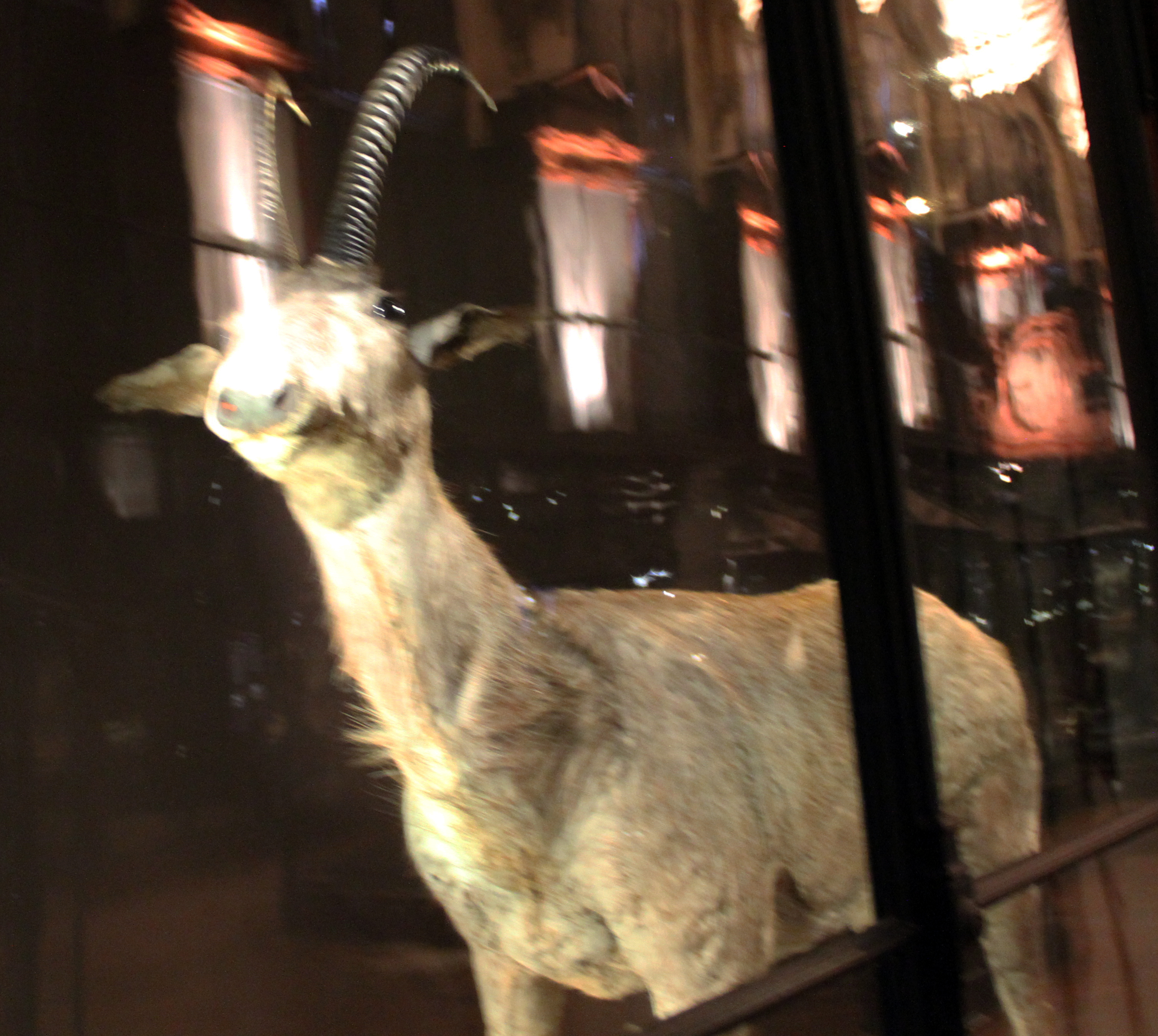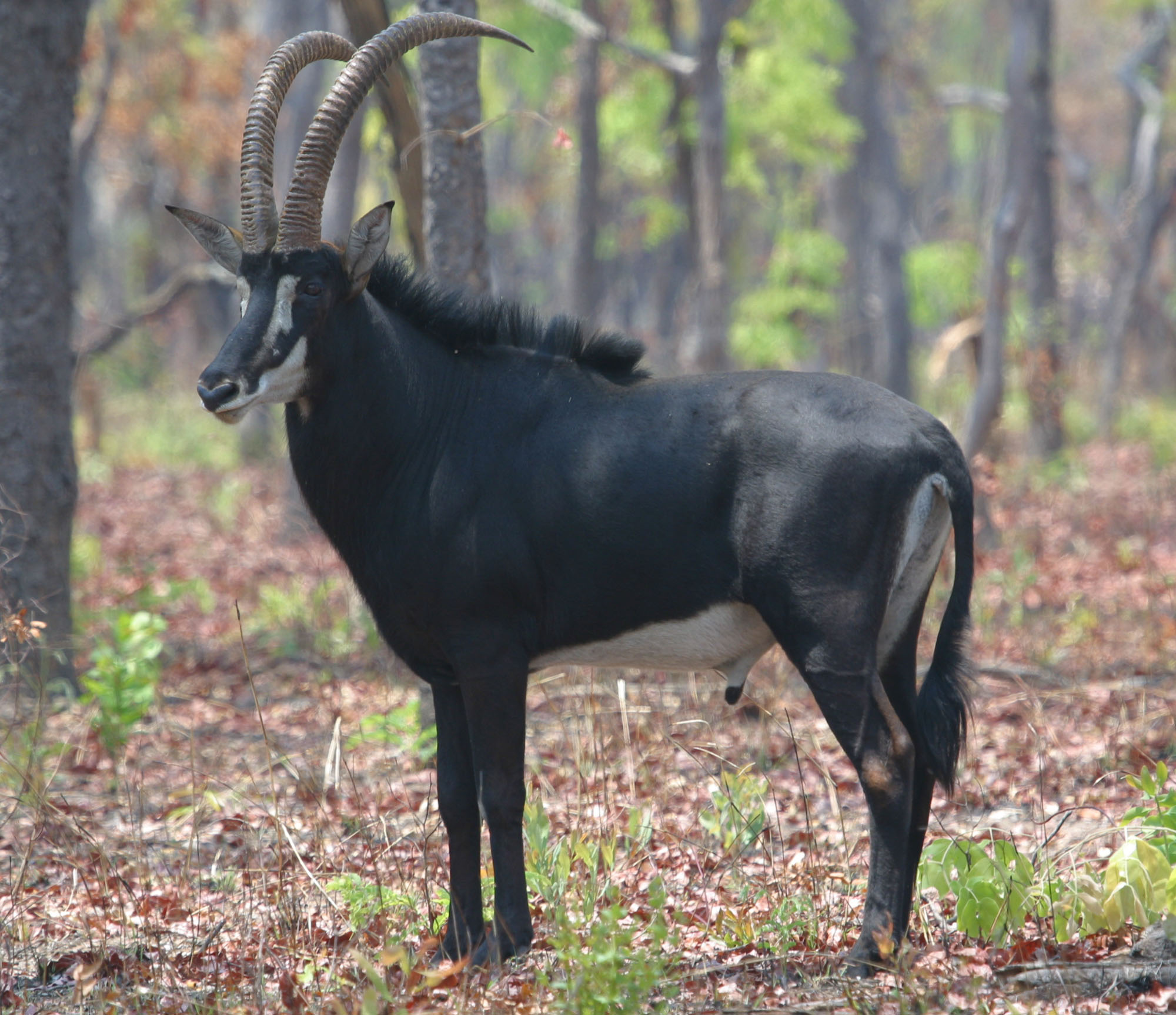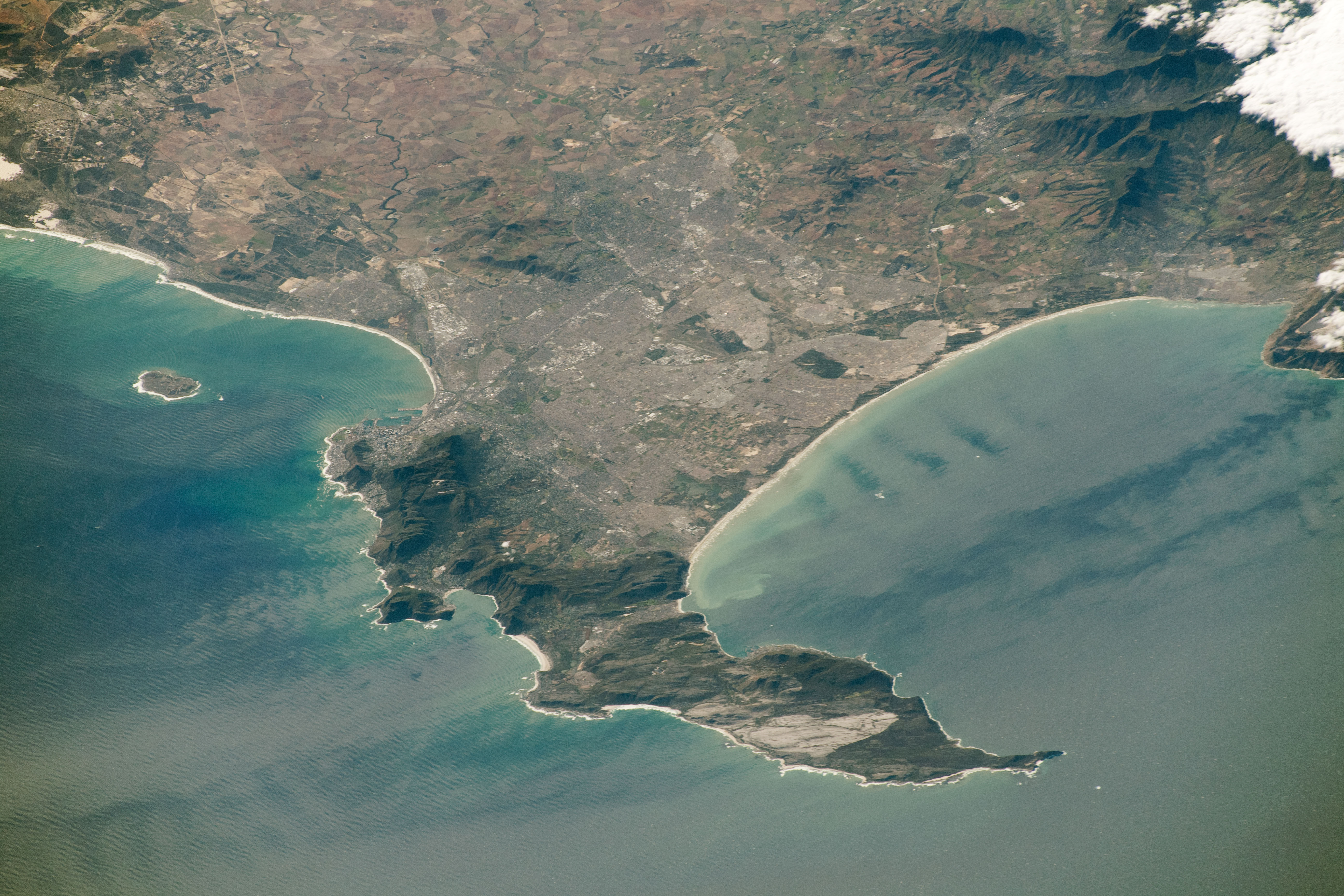|
Bluebuck
The bluebuck (Afrikaans: bloubok ) or blue antelope (''Hippotragus leucophaeus'') is an extinct species of antelope that lived in South Africa until around 1800. It was smaller than the other two species in its genus ''Hippotragus,'' the roan antelope and sable antelope. The bluebuck was sometimes considered a subspecies of the roan antelope, but a genetic study has confirmed it as a distinct species. The largest mounted bluebuck specimen is tall at the withers. Its horns measure along the curve. The coat was a uniform bluish-grey, with a pale whitish belly. The forehead was brown, darker than the face. Its mane was not as developed as in the roan and sable antelopes; its ears were shorter and blunter, not tipped with black; and it had a darker tail tuft and smaller teeth. It also lacked the contrasting black and white patterns seen on the heads of its relatives. The bluebuck was a grazer, and may have calved where rainfall, and thus the availability of grasses, would peak. ... [...More Info...] [...Related Items...] OR: [Wikipedia] [Google] [Baidu] |
Hippotragus
''Hippotragus'' is a genus of antelopes which includes two living and one recently extinct species, as well as some fossil relatives. The name comes from Greek ἵππος (''híppos''), "horse", and τράγος (''trágos''), "he-goat". Fossil species *†'' Hippotragus gigas'' *†'' Hippotragus cookei''? - may be a ''nomen dubium In binomial nomenclature, a ''nomen dubium'' (Latin for "doubtful name", plural ''nomina dubia'') is a scientific name that is of unknown or doubtful application. Zoology In case of a ''nomen dubium,'' it may be impossible to determine whether a ...'' References External links * Hippotraginae Mammal genera Taxa named by Thaddeus William Harris {{eventoedungulate-stub ... [...More Info...] [...Related Items...] OR: [Wikipedia] [Google] [Baidu] |
Subspecies
In Taxonomy (biology), biological classification, subspecies (: subspecies) is a rank below species, used for populations that live in different areas and vary in size, shape, or other physical characteristics (Morphology (biology), morphology), but that can successfully interbreed. Not all species have subspecies, but for those that do there must be at least two. Subspecies is abbreviated as subsp. or ssp. and the singular and plural forms are the same ("the subspecies is" or "the subspecies are"). In zoology, under the International Code of Zoological Nomenclature, the subspecies is the only taxonomic rank below that of species that can receive a name. In botany and mycology, under the International Code of Nomenclature for algae, fungi, and plants, other infraspecific name, infraspecific ranks, such as variety (botany), variety, may be named. In bacteriology and virology, under standard International Code of Nomenclature of Prokaryotes, bacterial nomenclature and virus clas ... [...More Info...] [...Related Items...] OR: [Wikipedia] [Google] [Baidu] |
Paris
Paris () is the Capital city, capital and List of communes in France with over 20,000 inhabitants, largest city of France. With an estimated population of 2,048,472 residents in January 2025 in an area of more than , Paris is the List of cities in the European Union by population within city limits, fourth-most populous city in the European Union and the List of cities proper by population density, 30th most densely populated city in the world in 2022. Since the 17th century, Paris has been one of the world's major centres of finance, diplomacy, commerce, culture, Fashion capital, fashion, and gastronomy. Because of its leading role in the French art, arts and Science and technology in France, sciences and its early adoption of extensive street lighting, Paris became known as the City of Light in the 19th century. The City of Paris is the centre of the Île-de-France region, or Paris Region, with an official estimated population of 12,271,794 inhabitants in January 2023, or ... [...More Info...] [...Related Items...] OR: [Wikipedia] [Google] [Baidu] |
Vienna
Vienna ( ; ; ) is the capital city, capital, List of largest cities in Austria, most populous city, and one of Federal states of Austria, nine federal states of Austria. It is Austria's primate city, with just over two million inhabitants. Its larger metropolitan area has a population of nearly 2.9 million, representing nearly one-third of the country's population. Vienna is the Culture of Austria, cultural, Economy of Austria, economic, and Politics of Austria, political center of the country, the List of cities in the European Union by population within city limits, fifth-largest city by population in the European Union, and the most-populous of the List of cities and towns on the river Danube, cities on the river Danube. The city lies on the eastern edge of the Vienna Woods (''Wienerwald''), the northeasternmost foothills of the Alps, that separate Vienna from the more western parts of Austria, at the transition to the Pannonian Basin. It sits on the Danube, and is ... [...More Info...] [...Related Items...] OR: [Wikipedia] [Google] [Baidu] |
Stockholm
Stockholm (; ) is the Capital city, capital and List of urban areas in Sweden by population, most populous city of Sweden, as well as the List of urban areas in the Nordic countries, largest urban area in the Nordic countries. Approximately 1 million people live in the Stockholm Municipality, municipality, with 1.6 million in the Stockholm urban area, urban area, and 2.5 million in the Metropolitan Stockholm, metropolitan area. The city stretches across fourteen islands where Mälaren, Lake Mälaren flows into the Baltic Sea. Outside the city to the east, and along the coast, is the island chain of the Stockholm archipelago. The area has been settled since the Stone Age, in the 6th millennium BC, and was founded as a city in 1252 by Swedish statesman Birger Jarl. The city serves as the county seat of Stockholm County. Stockholm is the cultural, media, political, and economic centre of Sweden. The Stockholm region alone accounts for over a third of the country's Gros ... [...More Info...] [...Related Items...] OR: [Wikipedia] [Google] [Baidu] |
Leiden
Leiden ( ; ; in English language, English and Archaism, archaic Dutch language, Dutch also Leyden) is a List of cities in the Netherlands by province, city and List of municipalities of the Netherlands, municipality in the Provinces of the Netherlands, province of South Holland, Netherlands. The municipality of Leiden has a population of 127,046 (31 January 2023), but the city forms one densely connected agglomeration with its suburbs Oegstgeest, Leiderdorp, Voorschoten and Zoeterwoude with 215,602 inhabitants. The Statistics Netherlands, Netherlands Central Bureau of Statistics (CBS) further includes Katwijk in the agglomeration which makes the total population of the Leiden urban agglomeration 282,207 and in the larger Leiden urban area also Teylingen, Noordwijk, and Noordwijkerhout are included with in total 365,913 inhabitants. Leiden is located on the Oude Rijn (Utrecht and South Holland), Oude Rijn, at a distance of some from The Hague to its south and some from Amsterdam ... [...More Info...] [...Related Items...] OR: [Wikipedia] [Google] [Baidu] |
Mammal
A mammal () is a vertebrate animal of the Class (biology), class Mammalia (). Mammals are characterised by the presence of milk-producing mammary glands for feeding their young, a broad neocortex region of the brain, fur or hair, and three Evolution of mammalian auditory ossicles, middle ear bones. These characteristics distinguish them from reptiles and birds, from which their ancestors Genetic divergence, diverged in the Carboniferous Period over 300 million years ago. Around 6,640 Neontology#Extant taxon, extant species of mammals have been described and divided into 27 Order (biology), orders. The study of mammals is called mammalogy. The largest orders of mammals, by number of species, are the rodents, bats, and eulipotyphlans (including hedgehogs, Mole (animal), moles and shrews). The next three are the primates (including humans, monkeys and lemurs), the Artiodactyl, even-toed ungulates (including pigs, camels, and whales), and the Carnivora (including Felidae, ... [...More Info...] [...Related Items...] OR: [Wikipedia] [Google] [Baidu] |
Effective Population Size
The effective population size (''N''''e'') is the size of an idealised population that would experience the same rate of genetic drift as the real population. Idealised populations are those following simple one- locus models that comply with assumptions of the neutral theory of molecular evolution. The effective population size is normally smaller than the census population size ''N'', partly because chance events prevent some individuals from breeding, and partly due to background selection and genetic hitchhiking. The same real population could have a different effective population size for different properties of interest, such as genetic drift (or more precisely, the speed of coalescence) over one generation vs. over many generations. Within a species, areas of the genome that have more genes and/or less genetic recombination tend to have lower effective population sizes, because of the effects of selection at linked sites. In a population with selection at many loci an ... [...More Info...] [...Related Items...] OR: [Wikipedia] [Google] [Baidu] |
Late Pleistocene
The Late Pleistocene is an unofficial Age (geology), age in the international geologic timescale in chronostratigraphy, also known as the Upper Pleistocene from a Stratigraphy, stratigraphic perspective. It is intended to be the fourth division of the Pleistocene Epoch within the ongoing Quaternary Period. It is currently defined as the time between 129,000 and c. 11,700 years ago. The late Pleistocene equates to the proposed Tarantian Age of the geologic time scale, preceded by the officially ratified Chibanian (commonly known as the Middle Pleistocene). The beginning of the Late Pleistocene is the transition between the end of the Penultimate Glacial Period and the beginning of the Last Interglacial around 130,000 years ago (corresponding with the beginning of Marine Isotope Stage 5). The Late Pleistocene ends with the termination of the Younger Dryas, some 10th millennium BC, 11,700 years ago when the Holocene Epoch began. The term Upper Pleistocene is currently in use as a p ... [...More Info...] [...Related Items...] OR: [Wikipedia] [Google] [Baidu] |
Rock Art
In archaeology, rock arts are human-made markings placed on natural surfaces, typically vertical stone surfaces. A high proportion of surviving historic and prehistoric rock art is found in caves or partly enclosed rock shelters; this type also may be called cave art or parietal art. A global phenomenon, rock art is found in many culturally diverse regions of the world. It has been produced in many contexts throughout human history. In terms of technique, the four main groups are: * cave paintings, * petroglyphs, which are carved or scratched into the rock surface, * sculpted rock reliefs, and * geoglyphs, which are formed on the ground. The oldest known rock art dates from the Upper Palaeolithic period, having been found in Europe, Australia, Asia, and Africa. Anthropologists studying these artworks believe that they likely had magico-religious significance. The archaeological sub-discipline of rock art studies first developed in the late-19th century among Francophone schola ... [...More Info...] [...Related Items...] OR: [Wikipedia] [Google] [Baidu] |
Cape Peninsula
The Cape Peninsula () of South Africa is a generally mountainous peninsula that juts out into the Atlantic Ocean at the south-western extremity of the African continent. At the southern end of the peninsula are Cape Point and the Cape of Good Hope. On the northern end is Table Mountain, overlooking Table Bay and the City Bowl of Cape Town, South Africa. The peninsula is 52 km long from Mouille point in the north to Cape Point in the south. The Peninsula has been an island on and off for the past 5 million years, as sea levels fell and rose with the Glacial period, ice age and interglacial global warming cycles of, particularly, the Pleistocene. The last time that the Peninsula was an island was about 1.5 million years ago. Soon afterwards it was joined to the mainland by the Geology of Cape Town#Tertiary to Recent events, emergence from the sea of the sandy area now known as the Cape Flats. The towns and villages of the Cape Peninsula and Cape Flats, and the undev ... [...More Info...] [...Related Items...] OR: [Wikipedia] [Google] [Baidu] |
Grazing
In agriculture, grazing is a method of animal husbandry whereby domestic livestock are allowed outdoors to free range (roam around) and consume wild vegetations in order to feed conversion ratio, convert the otherwise indigestible (by human digestive system, human gut) cellulose within grass and other forages into meat, milk, wool and other animal products, often on land that is unsuitable for arable farming. Farmers may employ many different strategies of grazing for crop yield, optimum production: grazing may be continuous, seasonal, or rotational grazing, rotational within a grazing period. Longer rotations are found in ley farming, alternating arable and fodder crops; in rest rotation, deferred rotation, and mob grazing, giving grasses a longer time to recover or leaving land fallow. Patch-burn sets up a rotation of fresh grass after burning with two years of rest. Conservation grazing proposes to use grazing animals to improve the biodiversity of a site. Grazing has existed ... [...More Info...] [...Related Items...] OR: [Wikipedia] [Google] [Baidu] |










